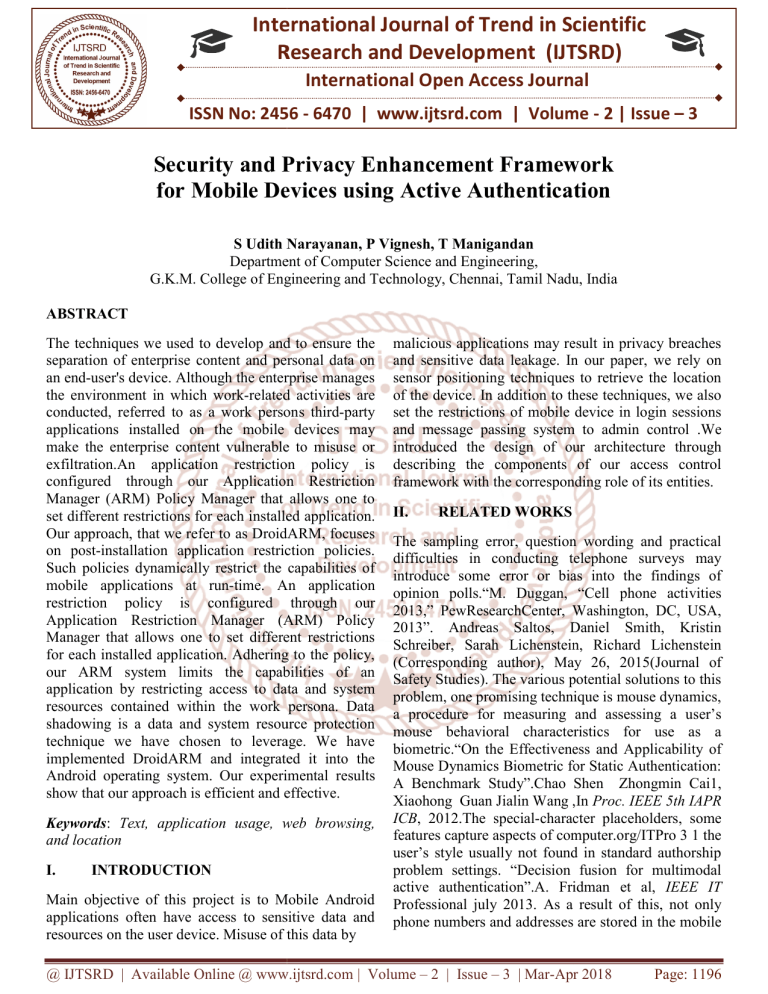
International Journal of Trend in Scientific
Research and Development (IJTSRD)
International Open Access Journal
ISSN No: 2456 - 6470 | www.ijtsrd.com | Volume - 2 | Issue – 3
Security and Privacy Enhancement Framework
for Mobile Devices using
sing Active Authentication
S Udith Narayanan, P Vignesh, T Manigandan
Department of Co
Computer Science and Engineering,
G.K.M. College of Engineering and Technology, Chennai, Tamil Nadu, India
ABSTRACT
The techniques we used to develop and to ensure the
separation of enterprise content and personal data on
an end-user's
user's device. Although the enterprise manages
the environment in which work-related
related activities are
conducted, referred to as a work person
persons third-party
applications installed on the
he mobile devices may
make the enterprise content vulnerable to misuse or
exfiltration.An
An application restriction policy is
configured through our Application Restriction
Manager (ARM) Policy Manager that allows one to
set different restrictions for each installed
nstalled application.
Our approach, that we refer to as DroidARM, focuses
on post-installation
installation application restriction policies.
Such policies dynamically restrict the capabilities of
mobile applications at run-time.
time. An application
restriction policy is configured
nfigured through our
Application Restriction Manager (ARM) Policy
Manager that allows one to set different restrictions
for each installed application. Adhering to the policy,
our ARM system limits the capabilities of an
application by restricting access too data and system
resources contained within the work persona. Data
shadowing is a data and system resource protection
technique we have chosen to leverage. We have
implemented DroidARM and integrated it into the
Android operating system. Our experimental results
show that our approach is efficient and effective.
Keywords: Text, application
pplication usage, web browsing,
and location
I.
INTRODUCTION
Main objective of this project is to Mobile Android
applications often have access to sensitive data and
resources on the user device. Misuse of this data by
malicious applications may result in privacy breaches
and sensitive data leakage. In our paper, we rely on
sensor positioning techniques to retrieve the location
of the device. In addition to these techniques, we also
set the restrictions of mobile device in login sessions
and message passing system to admin control .We
introduced the design of our architecture
a
through
describing the components of our access control
framework with the corresponding role of its entities.
II.
RELATED WORKS
The sampling error, question wording and practical
difficulties in conducting telephone surveys may
introduce some errorr or bias into the findings of
opinion polls.“M. Duggan, “Cell phone activities
2013,” PewResearchCenter, Washington, DC, USA,
2013”. Andreas Saltos, Daniel Smith, Kristin
Schreiber, Sarah Lichenstein, Richard Lichenstein
(Corresponding author), May 26, 2015(Journal
20
of
Safety Studies). The various potential solutions to this
problem, one promising technique is mouse dynamics,
a procedure for measuring and assessing a user’s
mouse behavioral characteristics for use as a
biometric.“On the Effectiveness and Applicability
Ap
of
Mouse Dynamics Biometric for Static Authentication:
A Benchmark Study”.Chao Shen Zhongmin Cai1,
Xiaohong Guan Jialin Wang ,In Proc. IEEE 5th IAPR
ICB, 2012.The special-character
character placeholders, some
features capture aspects of computer.org/ITPro
computer.org/I
3 1 the
user’s style usually not found in standard authorship
problem settings. “Decision fusion for multimodal
active authentication”.A. Fridman et al, IEEE IT
Professional july 2013. As a result of this, not only
phone numbers and addresses are stored
stor in the mobile
@ IJTSRD | Available Online @ www.ijtsrd.com | Volume – 2 | Issue – 3 | Mar-Apr
Apr 2018
Page: 1196
International Journal of Trend in Scientific Research and Development (IJTSRD) ISSN: 2456-6470
device but also financial information and business
details which definitely should be kept private.
“Unobtrusive User-Authentication on Mobile Phones
using Biometric Gait Recognition”.Mohammad O.
Derawi , Claudia Nickel , Patrick Bours and Christoph
Busch.In Proc. IEEE 6th Int. Conf. IIH-MSP, 2010.
III.
PROPOSED SYSTEM
In this paper we have proposed the restriction system
for application, there is the application blocking that
is internal and external application want to block
through the admin panel the particular application
connectivity The Administrator has set the privileges
to access the persons. The person has no permission to
access the restriction apps. She/he cannot access the
restriction application, and the menu options with the
message passing system into admin panel , the user
want to use restriction application for emergency
purpose incase user can pass the message into the
admin panel , if it’s the valid reason then the
administrator can allow to use application for that
user. There is extra propose in this, such that the
alarm notify the system to remind if the user forget to
logout the application. When the person login the
application it will be shown in the admin and can
restrict. There are also logout options in case if the
user logout then the person device cannot control.
Fig.2 Block diagram of ARS
A. Admin panel creation:
Develop the admin panel using the localhost
(wampserver & myphpadmin) and create the default
login account for all the application user along with
restriction menus.
B. Policy Manager:
The admin can control the android application only if
the terms and conditions (policy) are accepted by the
android user.
C. Authentication:
The authentication process will be done between the
mobile device & admin panel in the login account if
and only if login is successful and gets the user
permission to access the admin panel.
D. Admin restriction system:
If the user login the account in android mobile it will
be shown in the admin panel who are logging in
&being in online list only then admin can set the
privileges for users.
CONCLUSIONS
In this paper, we proposed parallel binary decisionlevel fusion architecture for classifiers based on four
biometric modalities: text, application usage, web
browsing, and location. Using this fusion method we
addressed the problem of active authentication and
characterized its performance on a real-world data set
of 200 subjects, each using their personal Android
mobile device for a period of at least 30 days.
@ IJTSRD | Available Online @ www.ijtsrd.com | Volume – 2 | Issue – 3 | Mar-Apr 2018
Page: 1197
International Journal of Trend in Scientific Research and Development (IJTSRD) ISSN: 2456-6470
REFERENCES
1. “Biometric Authentication Using Wavelet
Probabilistic Neural Network”.Ching-Han Chen,
Ching-Yi Chen2,2013 IEEE 17th International
Symposium on Consumer Electronics (ISCE).
2. “Towards Multiple User Active Authentication
in Mobile Devices”, Mattias Andersson ,
Hironao Okada, IEEE TENCON 2013 Journal
Publication.
3. “ Extracting IM evidence of Android apps Sign
In or Purchase”,Dr. Sridhar Mandapati , Sravya
Pamidi , Sriharitha Ambati,Journal of Computer
Engineering 2015.
4. “Monitoring
Temperature
Changes
in
Body”,Abdul Hadi H. Nograles, Felicito S.
Caluyo, IEEE INDICON 2013 Journal
Publication.
5. “Toward Writing Style Anonymization”,Akshata
V.S, Rumana Pathan, Poornima Patil, Farjana
Nadaf.International Journal of Core Engineering
and Management(IJCEM) 2014.
@ IJTSRD | Available Online @ www.ijtsrd.com | Volume – 2 | Issue – 3 | Mar-Apr 2018
Page: 1198

